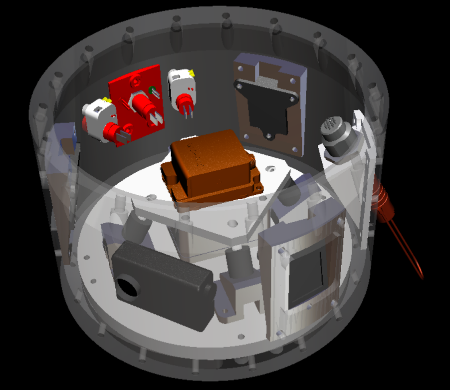Aether
At the end of the summer of 2015, the Advanced Control Team (ACT), the Structures Team, the Parachute Research Group, the Solid Propulsion Team, and the Electronics Team combined their visions to integrate their individual capabilities in a joint project. The objective was to:
Develop a supersonic technology demonstrator for future DARE space flight, with multiple DARE sub-teams, including active stabilization and high speed recovery.
Intended as a stepping stone technology demonstrator for future DARE space flight, project Aether aims to test a supersonic rocket that will showcase active aerodynamic stabilization through the use of steerable wings, and deploy a new high speed recovery concept by ejecting a drogue chute via a high pressure cold-gas mortar. To make these technologies ready in time, Aether will be powered by the biggest solid rocket engine ever developed by DARE, the Asimov engine.
New Technologies
As DARE’s technology demonstrator, Aether brings many new innovations together.
- Modular rocket design
- Modular flight electronics
- Supersonic active stabilization system
- High-speed parachute deployment system
- Attitude determination system
- DARE’s largest solid rocket motor
- Lightweight composite structure
All sections are connected via a modular coupling system, allowing for watertight sealing and easy assembly during the launch praparations.

Subsystems
Electronics

The nosecone houses the brain of the rocket, namely the flight computer, designed by the Electronics Team and makes use of the DARE modular flight stack. The flight computer is designed to be compatible with ACT-specific components, such as the MTi-100 Inertial Measurement Unit (IMU) sponsored by XSENS.
The Aether Flight Electronics consists of the following items:
- Battery Pack
- Power supply board
- Main processor board, including ACT software
- Actuation board for actuators
- Sensor board
- Telemetry board
Active Stabilization

After having successfully tested the Stability Augmentation System of the CanSat V7S developed by the Advanced Control Team, the team is upscaling the canard system for supersonic speeds. Project Aether is the first DARE rocket which features supersonic active stabilization.
The canard system is mechanically limited to do roll-stabilization only because the ACT still needs to test full control on a small scale. Via an integrated gearing system, the canards will always rotate into the same direction, which improves the safety of this system.
The Aerodynamics department within the ACT is performing dedicated Computational Fluid Dynamics (CFD) simulations, to study the flow of the canards in supersonic speeds and to optimize the design.
Parachute

Instrumentation

Engine

Height
1.75 m
5.7 ft
Diameter
20.8 cm
8.2 in
Dry Mass
40 kg
88.2 lb
Propellant Mass
40.2 kg
88.6 lb
Thrust
10400 N
2388 lbf
Specific Impulse
110 s
To ensure that Aether will lift-off and reaches supersonic velocity, the rocket is powered by the biggest solid rocket motor ever developed by DARE: the DXS-Icarus, derived from the DXS-Asimov engine, the previous largest engine from the Solid Propulsion Team. To ensure that the engine meets its maximum performance, various single grain motor (SGM) tests and full-scale motor (FSM) tests are conducted during the Aether development process.
It is unique in comparison to previous DARE’s engines, as it has a star shaped core to provide sufficient initial thrust to lift the rocket off of the tower. It features a composite combustion chamber, a steel nozzle and, a safety ingition valve.

The Structures Team is developing techniques to make the propulsion section completely out of composite materials—including the fins—which brings challenges when it comes to attaching composite materials together. Clever methods such as using local integrated aluminum reinforcement rings are considered as a feasible solution to guarantee a solid connection between the fins and tube, to cope with the aerodynamic loads acting on the fins.


